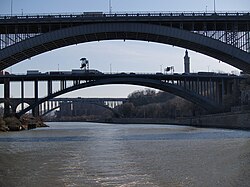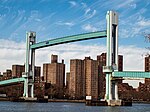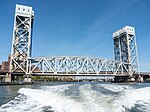Harlem River
| Harlem River | |
|---|---|
 | |
 The Harlem River, shown in yellow, between the Bronx and Manhattan in New York City. | |
| Location | |
| Country | United States |
| State | New York |
| Municipality | New York City |
| Physical characteristics | |
| Source | Hudson River |
| • coordinates | 40°52′42″N 73°55′33″W / 40.87843°N 73.92594°W |
| Mouth | East River |
• coordinates | 40°46′48″N 73°56′14″W / 40.78003°N 73.93710°W |
| Length | 8 mi (13 km) |
| Basin features | |
| Tributaries | |
| • left | Bronx Kill |
The Harlem River is an 8-mile (13 km) tidal strait in New York, United States, flowing between the Hudson River and the East River and separating the island of Manhattan from the Bronx on the New York mainland.
The northern stretch, also called the
Use

The Harlem River was the traditional
Historically, the west bank of the Harlem River was also an amusement destination. The area between 190th and 192nd Streets was occupied by the
Crossings
The Harlem River is spanned by seven swing bridges, four lift bridges, and four arch bridges,[7] and is navigable to any boat with less than 55 feet (17 m) of air draft. However, any boat requiring more than 5 feet (1.5 m) of clearance will require the Spuyten Duyvil Bridge to swing open. All other movable bridges on the Harlem River provide at least 24 feet (7.3 m) of clearance while closed, so boats and ships requiring between 5 and 24 feet (1.5 and 7.3 m) of clearance need only have one bridge swing open. These bridges replaced fixed bridges or lower bridges in the late 19th century to improve navigation. High Bridge was erected between 1837 and 1848 to carry the Croton Aqueduct across the river. It is the oldest bridge in New York City.
The New York City Department of Transportation advises that while they make every effort to ensure that all bridges are operating, many of them are under repair at any time, and outside contractors are responsible for opening of bridges under repair.
| Crossing | Image | Carries | Location | Coordinates |
|---|---|---|---|---|
| Wards Island Bridge |  
Top: closed position |
Pedestrian/bicycle | Wards Island
|
40°47′10″N 73°56′14″W / 40.7861°N 73.9371°W |
Robert F. Kennedy Triboro Lift Bridge (Harlem Lift Bridge)
|

|
NY State Route 900G (6 road lanes) | Manhattan and Randall's Island | 40°48′01″N 73°55′40″W / 40.8003°N 73.9278°W |
| Willis Avenue Bridge |   bottom: 2010 bridge |
Northbound auto traffic; Pedestrian/bicycle | Manhattan and the Bronx | 40°48′13″N 73°55′44″W / 40.8035°N 73.9289°W |
| Third Avenue Bridge | 
|
Southbound auto traffic; Pedestrian/bicycle | Manhattan and the Bronx | 40°48′27″N 73°55′57″W / 40.8076°N 73.9325°W |
Lexington Avenue Tunnel
|
IRT Lexington Avenue Line ( |
Manhattan and the Bronx | 40°48′34″N 73°56′00″W / 40.8095°N 73.9332°W | |
Park Avenue Bridge
|

|
Metro-North Railroad | Manhattan and the Bronx | 40°48′40″N 73°56′00″W / 40.8111°N 73.9333°W |
| Madison Avenue Bridge | 
|
Southbound/eastbound auto traffic; pedestrian/bicycle | Manhattan and the Bronx | 40°48′41″N 73°55′58″W / 40.8115°N 73.9327°W |
149th Street Tunnel
|
IRT White Plains Road Line ( |
Manhattan and the Bronx | 40°49′08″N 73°55′59″W / 40.8189°N 73.9331°W | |
| 145th Street Bridge | 
|
Westbound/eastbound auto traffic; pedestrian/bicycle | Manhattan and the Bronx | 40°49′10″N 73°55′59″W / 40.8195°N 73.9331°W |
| Macombs Dam Bridge | 
|
Westbound/eastbound auto traffic; pedestrian/bicycle | Manhattan and the Bronx | 40°49′41″N 73°56′02″W / 40.8281°N 73.9339°W |
| Putnam Bridge (1881–1960) |  |
Ninth Avenue El | Manhattan and the Bronx | 40°49′56″N 73°56′03″W / 40.8322°N 73.9343°W |
Concourse Tunnel
|
IND Concourse Line ( |
Manhattan and the Bronx | 40°49′50″N 73°56′03″W / 40.8306°N 73.9341°W | |
| High Bridge | 
|
Pedestrian | Manhattan and the Bronx | 40°50′32″N 73°55′49″W / 40.8423°N 73.9303°W |
| Alexander Hamilton Bridge | 
|
Manhattan and the Bronx | 40°50′44″N 73°55′43″W / 40.8456°N 73.9287°W | |
| Washington Bridge | 
|
Westbound/eastbound auto traffic; pedestrian/bicycle | Manhattan and the Bronx | 40°50′49″N 73°55′41″W / 40.8469°N 73.9281°W |
| University Heights Bridge | 
|
Westbound/eastbound auto traffic; pedestrian/bicycle | Manhattan and the Bronx | 40°51′46″N 73°54′54″W / 40.8628°N 73.9150°W |
| Broadway Bridge | 
|
train) | Manhattan Island and Marble Hill, Manhattan | 40°52′25″N 73°54′40″W / 40.8736°N 73.9111°W |
| Henry Hudson Bridge | 
|
Manhattan and the Bronx | 40°52′40″N 73°55′18″W / 40.8779°N 73.9218°W | |
| Spuyten Duyvil Bridge | 
|
Empire Connection
|
Manhattan and the Bronx | 40°52′42″N 73°55′32″W / 40.8783°N 73.9256°W |
See also
- Geography of New York City
- Geography of New York Harbor
- List of New York rivers
References
Notes
- Columbia University Record, 32:14:1 (June 11, 2007)
- ^ Martens, Victoria (August 1, 2019). "Fort George Amusement Park". Museum of the City of New York. Retrieved September 2, 2019.
- ISSN 0362-4331. Retrieved September 15, 2017.
- ISSN 0362-4331. Retrieved September 15, 2017.
- ISSN 0362-4331. Retrieved September 15, 2017.
- ^ Robinson, Lauren (February 28, 2012). "How Harlem River Speedway Became Harlem River Drive". Museum of the City of New York.
- ^ Reier, Sharon (1977). The Bridges of New York. Dover Press.
This article needs additional citations for verification. (November 2010) |
Further reading
- Botella, Rodrigue Ruiz (October 27, 2019). Harlem River. ISBN 978-1-702-82578-8., a novel that highlights the Harlem River and its surroundings
External links
 Media related to Harlem River at Wikimedia Commons
Media related to Harlem River at Wikimedia Commons
